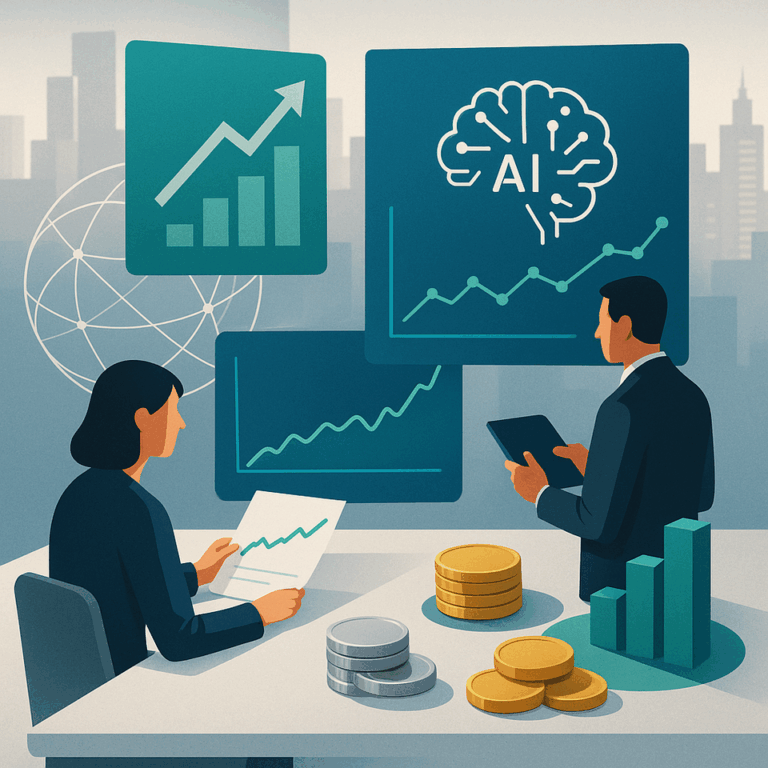Introduction: The Relevance of AI Long-Term Investments
AI long-term investments are becoming a transformative force in modern financial strategy. As advanced analytics and automation challenge traditional approaches, investors can harness these technologies to inform decisions, reduce risk, and optimize portfolios for the coming years. With rapidly evolving markets and exploding data volumes, understanding how artificial intelligence shapes long-term investment management is vital for anyone seeking sustainable growth and a competitive edge.
Defining Artificial Intelligence in Investing
Artificial intelligence in an investment context refers to the use of machine learning, natural language processing, and automation for enhanced financial analysis and decision making. These systems process massive data sets—ranging from historical securities pricing to non-traditional sources like news sentiment or environmental signals. AI-powered models identify patterns or trends that might go unnoticed by even the most experienced analysts.
Machine learning adapts portfolios in real time as new data comes in, while robo-advisors provide automated recommendations to retail and professional investors. Additionally, algorithmic trading harnesses AI to execute decisions at speeds and scales unreachable by humans. Institutions deploy AI for fraud detection, anti-money laundering, and regulatory compliance, further improving accuracy and speed. This wide range of applications helps ensure that investment management remains insightful, responsive, and efficient in a fast-changing world.
Why AI Matters for Long-Term Investors
Long-term investors face unique challenges: data overload, market volatility, and unpredictable economic cycles. AI long-term investments address these hurdles by providing advanced analytical capabilities, enhanced risk controls, and broader access to data-driven insights. With intelligent algorithms, investors can better identify opportunities early, manage diversified portfolios, and optimize rebalancing according to evolving financial conditions.
For example, pension funds and endowments use AI to model long-term scenarios, stress-test assumptions, and detect early signals from global events that may influence investment outcomes. By integrating non-traditional data, such as geospatial or behavioral information, AI helps uncover emerging trends long before they are reflected in traditional metrics. For individual investors, robo-advisors create tailored strategies based on unique risk profiles, life goals, and market outlook, streamlining what was once a resource-intensive process.
Strategic Use of AI in Modern Portfolio Management
Implementing AI in portfolio management starts with data gathering and cleaning. Once structured, this data is analyzed using AI tools to identify inefficiencies or latent risks. Portfolio managers can then simulate different investment strategies, stress-test them against historical crises, and assess the potential for drawdowns or sudden regime shifts.
Algorithmic models facilitate rapid rebalancing, monitor global exposures, and assess ESG (environmental, social, and governance) factors for sustainable investing. In private equity and real estate, machine learning interprets supply-demand patterns, market cycles, and environmental risks with greater precision. These insights result in improved asset allocation, reduced risk, and the ability to capitalize on emerging themes, such as renewable energy or health technology.
AI Long-Term Investments: Key Benefits and Opportunities
AI long-term investments deliver measurable advantages. First, enhanced data processing enables managers to analyze vast quantities of structured and unstructured data in minutes, identifying actionable insights that formerly took days or weeks. Continuous model improvement means that as new information arises, investment strategies adapt more nimbly to market changes.
Second, AI boosts diversification. Smart algorithms can optimize exposure to multiple asset classes based on evolving trends. For example, identifying the early rise of green bonds or crypto assets gives investors an edge. Third, predictive analytics help to spot market inefficiencies, generating alpha—that is, returns beyond traditional benchmarks. Fourth, automated systems cut human error and emotional bias, which often drive poor investment outcomes, thus fostering more disciplined execution over the long term.
Risks and Limitations of AI in Investment Decisions
Although the promise is great, AI long-term investments also bring unique risks. Algorithmic overfitting, where models are tailored too closely to historical data, can mislead future expectations. Poor data quality or incomplete data sets may result in unreliable or skewed forecasts. Additionally, proprietary “black box” models sometimes lack transparency, complicating due diligence efforts and reducing investor trust.
Regulatory concerns add complexity. Global guidelines on data governance, algorithmic accountability, and transparency vary significantly. Investors must remain vigilant about compliance, especially as authorities increase scrutiny on AI-driven systems. Cybersecurity is also a growing threat; as investment firms digitize operations, safeguarding sensitive information and infrastructure becomes essential.
To address these challenges, responsible investors must combine technology-specific risk controls with established best practices. Routine validation of AI outputs, critical reviews of model assumptions, and periodic stress testing help ensure prudent oversight and integrity in decision-making.
Case Studies: How AI Is Used in Long-Term Investing
Numerous financial institutions have already integrated AI into their core investing frameworks. For example, BlackRock’s Aladdin system leverages AI for risk management, scenario analysis, and real-time portfolio rebalancing. Meanwhile, robo-advisory leader Betterment deploys machine learning to construct personalized, passive investment portfolios for long-term growth. Pension funds worldwide utilize AI to evaluate thousands of possible asset mixes, simulating longevity and drawdown trends that protect against future liabilities.
In private markets, venture capital funds analyze startup ecosystems using AI, identifying promising companies based on network effects, patent filings, and digital footprints. Real estate investors use geospatial AI tools to forecast neighborhood growth, rental demand, and environmental impacts for decades into the future. These real-world applications show how implementing advanced analytics leads to better risk-adjusted outcomes and robust portfolio resilience over time.
Expanding Diversification and Alpha via AI
One of the most powerful advantages of AI long-term investments is improved diversification. Algorithms are not constrained by human biases or legacy paradigms. Instead, AI scans entire market universes, flagging underexplored opportunities and shifting capital efficiently between regions or sectors. In addition, constant model refinement identifies persistent anomalies—such as pricing inefficiencies or thematic developments—that can provide alpha, helping portfolios outperform traditional indices.
Moreover, AI assimilates alternative data—satellite images, social media trends, and IoT signals—to forecast local economies or detect supply chain disruptions. This expanded dataset enables tactical adjustments, allowing investors to avoid concentration risks and exploit unexplored sources of growth. For instance, as markets increasingly factor in climate risk, AI can help re-weight portfolios toward companies with sustainable practices or green innovation, aligning long-term investments with both return and responsibility.
Emerging Regulatory and Data Trends Shaping AI in Investing
The future of AI long-term investments is tightly linked to regulatory evolution and data availability. Global regulators like the U.S. SEC and ESMA are publishing guidelines to enhance the transparency and accountability of AI use in finance. Enhanced model explainability, standardized audit trails, and mandatory reporting are gradually becoming the norm, especially for systematically important firms.
Open banking, cloud computing, and data-sharing frameworks foster a new era of accessible, affordable AI tools for investors of all sizes. Collaborative data pools mean richer, cleaner datasets, leading to more robust decision-making. However, with great data comes great responsibility; firms must prioritize data privacy, cybersecurity, and ethical considerations when designing and deploying models. This converging landscape of innovation and oversight challenges investors to continuously adapt and invest in both infrastructure and education.
The Importance of Financial Education in the AI Age
As AI long-term investments proliferate, robust financial education becomes more critical than ever. Investors must not only understand investment fundamentals but also grasp how algorithms function, where their limits are, and how data quality shapes outcomes. Training in critical thinking and digital literacy enables investors to interpret AI-generated insights, challenge assumptions, and avoid blindly following automated recommendations.
In practice, this means combining analytic discipline with professional skepticism: always questioning data sources, validating model logic, and remaining vigilant about behavioral biases. Regulators and industry groups, such as the OECD, stress ongoing learning to ensure market integrity and investor protection. The more informed investors are, the more responsibly they can harness AI’s power for lasting wealth creation.
Best Practices for Navigating the AI Investment Landscape
To make the most of AI long-term investments, follow these best practices. Start with a clear investment policy and define your long-term objectives and risk tolerance. Then, select technology partners or platforms with transparent methodologies, robust data controls, and proven track records. Regularly review and stress-test AI models; avoid placing full trust in any “black box” system.
Combine AI recommendations with human judgment to ensure a balanced approach. Routinely audit portfolio performance and compare AI-driven insights to traditional methods. Engage in continuing education on financial markets and emerging technologies. Lastly, maintain open communication with stakeholders about how AI impacts investment strategies, risks, and expected outcomes. This transparent approach builds trust and prepares you for the next wave of financial innovation.
Conclusion
The rise of AI long-term investments is redefining investment management for a new era. Embracing these tools with a prudent mindset and solid financial education allows investors to capitalize on innovation, manage risks, and build durable portfolios. As regulatory norms evolve and data-driven technologies expand, those who stay informed and agile will shape the future of finance and capture opportunities others miss. Keep learning, question assumptions, and leverage both technology and education as your compass in the evolving world of long-term investing.



